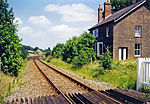Hanwood Road railway station
Disused railway stations in ShropshirePages with no open date in Infobox stationRailway stations in Great Britain closed in 1866Railway stations in Great Britain closed in 1880Railway stations in Great Britain closed in 1933 ... and 4 more
Railway stations in Great Britain opened in 1866Railway stations in Great Britain opened in 1868Railway stations in Great Britain opened in 1911West Midlands (region) railway station stubs
Hanwood Road railway station was a station in Edgebold, Shropshire, England. The station opened as Edgebold railway station, opened in 1866 and closed in 1933.
Excerpt from the Wikipedia article Hanwood Road railway station (License: CC BY-SA 3.0, Authors).Hanwood Road railway station
A488,
Geographical coordinates (GPS) Address Nearby Places Show on map
Geographical coordinates (GPS)
| Latitude | Longitude |
|---|---|
| N 52.6864 ° | E -2.8123 ° |
Address
A488
SY5 8NY , Great Hanwood
England, United Kingdom
Open on Google Maps









